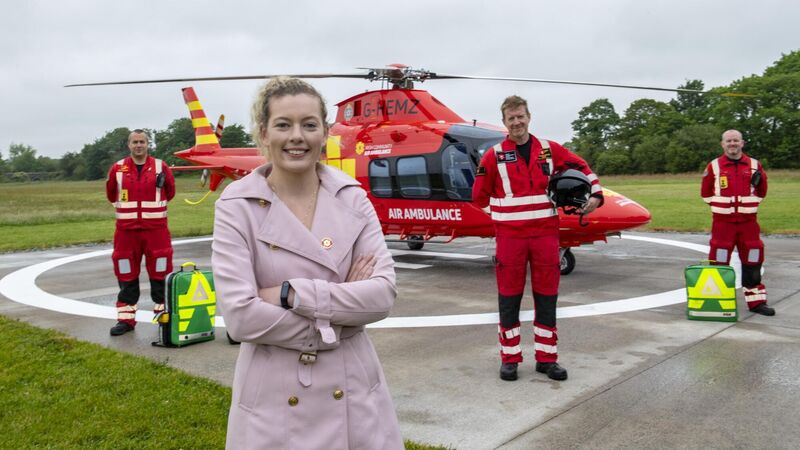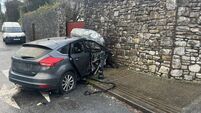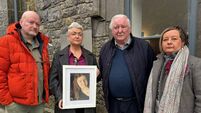Cork woman who 'died' after cardiac arrest thanks emergency response teams for saving her

Clodagh Lynch joined the crew of the Irish Community Air Ambulance in north Cork as its new helicopter went into service. It’s the fastest civilian helicopter in the world. Clodagh travelled in the previous helicopter from Bantry to Cork University Hospital after she suffered a sudden cardiac arrest. With Clodagh are, from left, Paul Traynor, Advanced Paramedic; Donagh Verling, Chief Pilot and James Ward, Advanced Paramedic. Picture: Brian Lougheed
A young woman who “died” in her back garden has visited the air ambulance crew who helped save her life to say thanks.
Clodagh Lynch, 20, from Bantry in Cork, was airlifted to Cork University Hospital within 15-minutes last May after suffering a sudden cardiac arrest event, similar to Danish footballer Christian Eriksen, and said if it wasn’t for the quick actions of all the emergency response teams that day, she wouldn’t be alive today.
Clodagh and her father, Gene, visited the crew of the Irish Community Air Ambulance in north Cork yesterday to say thanks, and was shown their new Leonardo 109S helicopter - the fastest civilian helicopter in the world - which will be able to get patients to hospitals even faster.
Clodagh, a UCC student, was sitting down talking to her mother Joan, a nurse, in the garden at home on May 20 last when her heart stopped.
“My mother hit me on the shoulder knowing I would give out to her for doing that but I gave no response., she said.
Clodagh’s mother immediately began CPR and her brother, John, contacted the National Ambulance Service, which in turn tasked the Irish Community Air Ambulance. The aircraft arrived on scene in Bantry within 13 minutes.
“Once I was stabilised, I was airlifted to Cork University Hospital. I spent six weeks recovering before I was allowed home. I believe that only for the quick actions of all the emergency response teams that I wouldn’t be here today otherwise,” Clodagh said.
John said their family home is more than 80km away from Cork city.
“The Irish Community Air Ambulance was vital in getting her to CUH and admitted into intensive care so fast,” he said.
“The air ambulance provides outstanding emergency care through the dedicated heli-med service and the rapid response vehicles.
“It’s hard to believe that they are not government funded; they rely on donations from the public to remain in operation.

“It’s an invaluable and life-saving service that’s incredibly important for the people of rural Ireland. We will forever be grateful for what they’ve done for Clodagh.”
The charity heli-med service has responded to almost 1,000 incidents from its base in Rathcoole since it was established in July 2019.
Cardiac arrests account for the most incidents so far this year, followed by road traffic collisions and farming accidents.
The new aircraft is faster, provides greater patient comfort and it has the capacity to take on more fuel increasing endurance and range.
It can fly at speeds of up to 300kph and is capable of flying the length of the country from Mizen to Malin Head in a little over 90 minutes. The same journey would take 8 hours by road.
Irish Community Air Ambulance Chief Executive Mícheál Sheridan said when you’re dealing with patients in critical condition, the small gains can have the greatest benefit to the patient’s comfort and outcomes.
“This new helicopter offers more speed but it also has additional room at the rear. That means that we can transport adult patients more comfortably and we also have space for an additional medic on board, if necessary,” he said.
The air ambulance is expected to cost €1.55m to run this year and relies entirely on fundraising. Each mission costs an average of €3,500.














